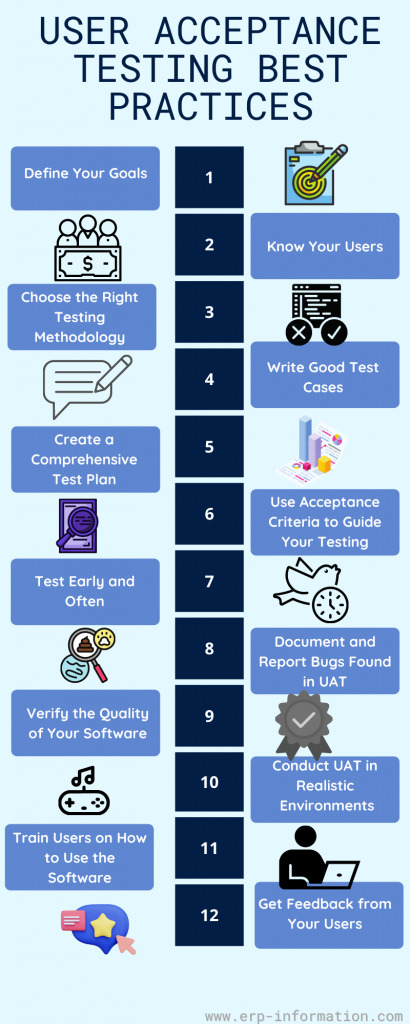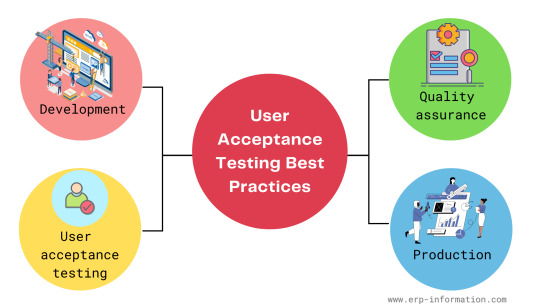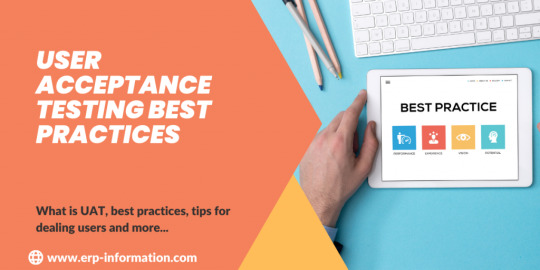#UserAcceptanceTesting
Explore tagged Tumblr posts
Text
For a high-quality software application delivery, use our software application testing solution. For more details, visit: https://briskwinit.com/software-product-testing/
#softwaretesting#testingserviceinindia#automation#softwareregressiontesting#systemintegration#testingservices#softwaretestingservices#softwaretestingcompany#bugfree#retesting#useracceptancetesting
5 notes
·
View notes
Text
From Bugs to Perfection – QAontop’s User Acceptance Testing Solutions
At QAontop Software Solutions, we ensure your software meets the highest standards before launch with our User Acceptance Testing services. From identifying bugs to achieving perfection, our expert QA team helps businesses deliver flawless user experiences. Trust QAontop to validate functionality, enhance performance, and ensure seamless user satisfaction.
0 notes
Text
Mastering UAT in Dubai’s Dynamic Market: A Guide for Agile Success
Table of Contents
Introduction
What is User Acceptance Testing (UAT)?
The Role of UAT in Agile Methodology
The Importance of UAT in Dubai and the UAE Market
Key Benefits of UAT for Businesses in Dubai
How Agile Advisors Support UAT in the UAE
UAT Process Steps and Best Practices
Challenges in UAT and How to Overcome Them
Conclusion

1. Introduction
A key procedure in software development, user acceptance testing (UAT) ensures that a product satisfies the requirements and expectations of the final user. UAT is essential to delivering high-quality, valuable products in Dubai's and the UAE's changing commercial environment. In this article, we discuss the value of UAT, especially in Agile approaches, and how UAE-based companies can profit from this testing stage.
2. What is User Acceptance Testing (UAT)?
The last stage of software testing is User Acceptance Testing (UAT), during which the intended user base tests the program to ensure it functions as intended. Real users verify the system's functionality at this phase, guaranteeing that the final product is easy to use and satisfies the precise specifications listed in the business objectives. UAT prioritizes practical application and usability over technical functionality.
3. The Role of UAT in Agile Methodology
User Acceptance Testing (UAT) is an ongoing, iterative process that adheres to Agile development principles. Agile strongly emphasizes producing usable software quickly, and UAT is essential to ensuring that the final result meets user expectations. Organizations are frequently guided through this process by Agile Advisors in the UAE to ensure that the results of each sprint satisfy the users' expectations.
UAT is usually carried out at the conclusion of each sprint or iteration in Agile to ensure that the final product adds value for the client. Agile advisors assist in managing UAT by ensuring that the testing procedure is incorporated into the sprint cycles and that feedback loops are prompt and effective.
4. The Importance of UAT in Dubai and the UAE Market
Rapid technical innovation, a competitive corporate environment, and a wide range of client needs define Dubai and the UAE market. In this context, UAT becomes even more critical since companies must produce software that satisfies functional needs and conforms to user expectations in a tech-savvy, multicultural market.
Since many companies work in fast-paced sectors like retail, real estate, and finance, it is crucial to ensure that software is both practical and easy to use. By implementing UAT, businesses in Dubai can lower expenses, increase customer happiness, and minimize risks.
5. Key Benefits of UAT for Businesses in Dubai
Improved Customer Satisfaction: UAT ensures that the software meets user expectations, leading to a more satisfied customer base.
Reduced Risks: By identifying potential issues before the software goes live, UAT helps mitigate risks that could arise post-launch.
Higher Quality Product: Through real-world testing, UAT helps businesses ensure their product is of high quality and free from critical flaws.
Faster Time-to-Market: By involving users early in the process, UAT helps businesses quickly identify issues and resolve them, accelerating the software’s release.
6. How Agile Advisors Support UAT in the UAE
Agile Advisors in Dubai offer specialized services that help businesses implement and manage User Acceptance Testing (UAT) within the framework of Agile development. These advisors bring expertise in facilitating UAT by:
Training and Coaching: Providing guidance on UAT best practices and ensuring teams are prepared for testing.
Test Planning: Helping businesses create detailed test plans that align with Agile sprints and milestones.
Coordinating User Feedback: Collecting and analyzing feedback from users during UAT to make quick adjustments before product release.
Ensuring Business Alignment: Ensuring that the software meets both technical and business requirements, bridging any gaps between developers and stakeholders.
7. UAT Process Steps and Best Practices
The UAT process is critical for ensuring successful software deployment. Here are the key steps involved:
Step 1: Requirements Gathering: Understand the business requirements and how they translate into software features.
Step 2: Test Plan Creation: Define the test scenarios, users, and success criteria.
Step 3: User Training: Prepare users for the testing process with proper documentation and training.
Step 4: UAT Execution: Have the end users execute the test cases based on real-world use scenarios.
Step 5: Feedback Collection: Gather feedback and identify any issues.
Step 6: Issue Resolution: Address the issues found during testing and retest as necessary.
Step 7: Final Approval: Once the product passes UAT, it’s ready for deployment.
Best Practices:
Involve actual users from the target market.
Start testing early in the Agile cycle.
Keep the testing process transparent and collaborative.
Ensure clear communication between all stakeholders.
8. Challenges in UAT and How to Overcome Them
While UAT is essential, it comes with challenges, especially in fast-paced environments like Dubai and the UAE:
Miscommunication: Clear communication between business teams, development teams, and users is crucial. Agile Advisors can help manage expectations.
Limited Resources: Organizing UAT with a limited number of testers can be challenging. Strategic planning and proper resource allocation are essential.
Tight Timelines: Agile development demands quick iterations. To address this, plan UAT as part of the Agile sprint and ensure timely feedback loops.
9. Conclusion
A crucial step in the software development process, user acceptance testing (UAT) makes sure the finished product satisfies user expectations and business requirements. In addition to lowering risks, UAT guarantees that software offers customers genuine value for companies in Dubai and the UAE. In a competitive and fast-paced market, working with Agile Advisors can assist in expediting UAT procedures and guarantee the successful delivery of high-quality software products. Businesses may guarantee better product outputs, increased customer happiness, and improved overall business success by integrating UAT as a core component of the Agile process.
0 notes
Text

For your better comprehension, this special acceptance testing lesson will provide you with a thorough rundown of the types, applications, meaning, and other aspects of acceptance tests in an easy-to-understand format.
#AcceptanceTesting#SoftwareTesting#QA#QualityAssurance#UserAcceptanceTesting#UAT#TestingProcess#SoftwareQuality#BugFreeSoftware#SystemTesting#TestAutomation#AgileTesting#PerformanceTesting#SoftwareDevelopment#QAProcess#EndUserTesting#FunctionalTesting
0 notes
Text
Performance testing and security testing are both crucial aspects of software quality assurance, but they serve different purposes. Performance testing focuses on evaluating the speed, responsiveness, and scalability of a system under various conditions, ensuring it meets performance requirements. On the other hand, security testing aims to identify vulnerabilities and weaknesses in a system's security controls, protecting it from potential threats and breaches. While both testers play vital roles in ensuring software reliability, neither reigns supreme over the other. Instead, a comprehensive testing strategy incorporates both performance and security testing to deliver robust, high-quality software solutions.
0 notes
Text
Acceptance Testing
Domain-led testing services across technological platforms for ensuring business readiness of applications.
Feature-enriched enterprise applications are built to cater to specific customer requirements. We, at Yethi, ensure to enhance the application quality while managing the budget and time constraints. Through acceptance testing, we fully investigate the formal expression of your business needs.

Our quality assurance services efficaciously addresses the gap between industry expertise and technical knowledge by blending the skills for domain, testing and automation to provide cost and time effective services.
0 notes
Text
The Secret to Intuitive OSS: Your Ultimate Guide to Telecom OSS Testing
A non-intuitive #OSS system can be a nightmare for users. Understand the significance of having an intuitive OSS interface and how rigorous #testing can enhance the UX.
Dive into our latest blog post! https://www.avisysservices.com/blog/the-secret-to-intuitive-oss-your-ultimate-guide-to-telecom-oss-testing-part-1/

#TelecomOSS#OSSSolutions#Telco#OSSTesting#UserExperience#UX#TelcoTech#TelecomSolutions#NetworkOperations#AgileTesting#ContinuousTesting#TestingCoE#UserAcceptanceTesting#UsabilityTesting#ABTesting#TelecomOperations#QualityAssurance#QA#RigorousTesting#CustomerExperience#DigitalTransformation#TechTrends#OSSBSS#BSS#TelcoRevolution#TelecomRegulations#5G
0 notes
Text
Common Pitfalls to Avoid in E-commerce User Acceptance Testing
User acceptance testing (UAT) plays a crucial role in ensuring the success of online businesses. As the final testing phase before a product or feature is launched, UAT allows key stakeholders to validate its functionality, usability, and overall user experience. However, despite its importance, there are several common pitfalls that businesses should be aware of and avoid during the UAT process.
Read more:
https://www.testingxperts.com/blog/ecommerce-user-acceptance-testing
0 notes
Text

𝐒𝐨𝐟𝐭𝐰𝐚𝐫𝐞 𝐃𝐞𝐯𝐞𝐥𝐨𝐩𝐦𝐞𝐧𝐭 𝐋𝐢𝐟𝐞𝐜𝐲𝐜𝐥𝐞 𝐚𝐭 𝐒𝐚𝐦𝐡𝐢𝐫𝐞𝐬 𝐋𝐋𝐂
Samhires LLC follows a comprehensive Software Development Lifecycle (SDLC) process to ensure the delivery of high-quality software solutions. The SDLC at Samhires consists of several key phases:
𝐏𝐥𝐚𝐧𝐧𝐢𝐧𝐠: This initial phase involves defining the project scope, objectives, timelines, and resource requirements. A project plan is created to guide the development process.
𝐀𝐧𝐚𝐥𝐲𝐬𝐢𝐬: Requirements are gathered from stakeholders and analyzed to understand the project's functional and non-functional requirements.
𝐃𝐞𝐬𝐢𝐠𝐧: Based on the analysis, the software architecture is designed, including the system's structure, interfaces, and data management strategies.
𝐃𝐞𝐯𝐞𝐥𝐨𝐩𝐦𝐞𝐧𝐭: Developers write code according to the design specifications, following best practices and coding standards. Continuous integration and testing are performed to ensure code quality.
𝐓𝐞𝐬𝐭𝐢𝐧𝐠: The software undergoes various testing phases, including unit testing, integration testing, and user acceptance testing, to identify and fix bugs.
𝐃𝐞𝐩𝐥𝐨𝐲𝐦𝐞𝐧𝐭: Once the software passes testing and receives approval, it is deployed to the production environment. Deployment strategies ensure minimal downtime and risk.
𝐌𝐚𝐢𝐧𝐭𝐞𝐧𝐚𝐧𝐜𝐞: After deployment, the software is monitored and maintained to ensure it remains functional and secure. Regular updates and patches are applied to address issues and improve performance.
By following this SDLC process, Samhires LLC delivers software solutions that meet client requirements and industry standards.
SoftwareDevelopmentLifecycle #SDLC #Planning #Analysis #Design #Development #Testing #Deployment #Maintenance #HighQualitySoftware #ContinuousIntegration #BestPractices #CodingStandards #UserAcceptanceTesting #DeploymentStrategies #SoftwareMaintenance #ClientSatisfaction #IndustryStandards #SamhiresLLC
0 notes
Link
When new features are added or modified or an existing system is replaced, may cause anxiety among the end users regarding the impact of the changes. But since the UAT is performed by the business users in environments suited to them, UAT in the development cycle eases out that stress and increases the confidence level of the users about the software before it is brought to them for usage.
0 notes
Text
For a high-quality software application delivery, use our software application testing solution. For more details, visit: https://briskwinit.com/software-product-testing/
#softwaretesting#testingserviceinindia#automation#softwareregressiontesting#systemintegration#testingservices#softwaretestingservices#softwaretestingcompany#bugfree#retesting#useracceptancetesting
4 notes
·
View notes
Text
Understanding User Acceptance Testing (UAT): A Comprehensive Guide
Table of Contents
Introduction
What is User Acceptance Testing (UAT)?
The Importance of UAT in the Software Development Lifecycle
The Role of Agile Advisors in UAT
Key Steps in the UAT Process
Best Practices for Effective User Acceptance Testing
Common Challenges in UAT and How to Overcome Them
Conclusion

1. Introduction
Delivering high-quality solutions that satisfy consumer expectations is crucial in the software development industry. A key component of making sure software solutions are prepared for delivery is User Acceptance Testing (UAT). UAT becomes even more important in an Agile development environment, and the testing process can be significantly enhanced with the correct advice from Agile Advisors.
This blog covers the definition of UAT, its significance, and the ways in which Agile Advisors can help teams achieve effective results at this stage.
2. What is User Acceptance Testing (UAT)?
The last stage of software testing is called User Acceptance Testing (UAT), during which end users test the program to ensure it satisfies their requirements and expectations. In contrast to other testing phases (like unit testing or integration testing), UAT is centred on verifying the program from the viewpoint of the actual user, making sure it functions as intended in a real-world situation.
User Acceptance Testing (UAT) aims to verify that the system functions for the user and satisfies the business criteria it was created to fulfil. This step helps find any possible problems or defects that might have gone unnoticed earlier in the development process.
3. The Importance of UAT in the Software Development Lifecycle
User Acceptance Testing (UAT) is essential because it facilitates communication between the users and the development team. The following are some main justifications for why UAT is necessary:
Ensures the Software Meets Business Requirements: UAT confirms that the product aligns with the business goals and objectives.
Reduces Risks: By involving users in the final testing phase, UAT helps uncover any remaining issues that could negatively impact the user experience.
Improves User Satisfaction: Testing with real users ensures the software is intuitive and user-friendly, leading to a better user experience.
Prevents Costly Post-Release Fixes: By catching issues early in UAT, businesses can save on the costs associated with post-release bug fixes and updates.
4. The Role of Agile Advisors in UAT
Agile Advisors bring a unique set of skills and expertise to the User Acceptance Testing (UAT) process, particularly in an Agile development environment. They help teams navigate the complexities of testing by offering guidance in several key areas:
Facilitating Collaboration: Agile Advisors ensure that there is clear communication between developers, testers, and end-users. They foster collaboration throughout the UAT process, which is crucial for a smooth testing experience.
Defining Testing Requirements: With their experience in Agile methodologies, Agile Advisors help define clear and measurable acceptance criteria, ensuring that the UAT process is aligned with user needs.
Managing Stakeholder Expectations: UAT can sometimes reveal issues that require changes or compromises. Agile Advisors help manage stakeholders’ expectations and prioritize issues to ensure that the most critical problems are addressed first.
Ensuring Continuous Improvement: Agile Advisors ensure that the feedback from UAT is used to improve future development cycles, fostering a culture of continuous improvement.
5. Key Steps in the UAT Process
User Acceptance Testing (UAT) typically follows a structured process, which can vary slightly depending on the project. However, the key steps include:
1. Planning:
Defining the scope, objectives, and acceptance criteria for the UAT process. This stage also involves identifying the target users who will perform the testing.
2. Test Case Development:
Creating detailed test cases based on business requirements. These test cases should reflect real-world scenarios and user workflows.
3. Test Environment Setup:
Preparing the testing environment to mirror the live system as closely as possible. This ensures that users can test in conditions similar to the production environment.
4. Executing Tests:
Users run the tests based on the predefined test cases. During this phase, it���s important to document any issues or discrepancies that arise.
5. Feedback and Resolution:
After completing the tests, users provide feedback. The development team addresses any issues, which may involve bug fixes or further refinements.
6. Final Sign-Off:
After the problems have been fixed and users are happy with the system, they give a formal sign-off, certifying that it is prepared for deployment.
6. Best Practices for Effective User Acceptance Testing
To maximize the effectiveness of User Acceptance Testing (UAT), consider implementing the following best practices:
Involve End-Users Early: Involve the actual users early in the testing process to ensure that the testing covers real-world scenarios and workflows.
Clearly Define Acceptance Criteria: Define clear, measurable criteria for what constitutes a successful test to avoid confusion and ensure that the UAT process remains focused.
Keep UAT Test Cases Simple and Realistic: Test cases should reflect real-world usage and be easy to execute. This ensures that users can perform them without issues.
Track and Prioritize Issues: Not all issues found during UAT are equally important. Track and prioritize them to address the most critical problems first.
Ensure Adequate Training: Provide proper training for users involved in UAT to ensure they can effectively test the system and provide meaningful feedback.
7. Common Challenges in UAT and How to Overcome Them
While User Acceptance Testing (UAT) is essential, it can come with its own set of challenges:
Lack of User Engagement: If users are not fully engaged in UAT, critical feedback may be missed. To overcome this, ensure that users understand the importance of their role in UAT and provide incentives or clear incentives to participate.
Ambiguous Acceptance Criteria: Unclear criteria can lead to confusion and inconsistencies in testing. Agile Advisors can help establish clear, measurable criteria that guide the testing process.
Environment Mismatches: Differences between the test and production environments can result in discrepancies. Ensuring a proper match between the testing and production environments is critical to minimize this challenge.
8. Conclusion
A crucial phase in the software development lifecycle, user acceptance testing (UAT) ensures that the final product satisfies end users' requirements and expectations. Agile advisors are essential in supporting UAT, assisting teams efficiently, and navigating the procedure. Organizations can ensure their software is ready for release and give users a product that fulfils business objectives and delivers value by adhering to best practices and resolving frequent issues.
0 notes
Photo

Join this free online course about #designtesting #useracceptancetesting & #validation https://t.co/PbqdzPEqPV https://t.co/A3wOlIOqxt #SAP
0 notes
Text
User Acceptance Testing Best Practices - 12 Tips



User Acceptance Testing (UAT) is an essential part of the software development process, but knowing the best way to do it can be challenging. There are a lot of different opinions about how to do acceptance testing, and it can be hard to know which one is right for you. This blog post will talk about User Acceptance Testing Best Practices. We'll go over twelve tips to help you do user acceptance testing the right way and ensure your software is ready for release. We also covered tips for dealing with demanding users and UAT automated tools.
What is User Acceptance Testing, and Why is it important?
User acceptance testing (UAT) is software testing that the end-user or client performs to verify that the system meets their expectations. It is essential because it allows the user to confirm that the system meets their needs before it is put into production.
User Acceptance Testing Best Practices
The below infographic illustrates the best practices for user acceptance testing.

- Define Your Goals - Before you start writing test cases or running tests, you must know what you're trying to accomplish with your acceptance testing. What are the objectives of your project? What do you want to learn from your users? - Know Your Users - It's essential to understand who your users are and what they need from your software. What are their goals? What are their skills and abilities? How will they be using your software? - Choose the Right Testing Methodology - Not all testing methodologies are created equal. You need to choose the right one for your project. There are many different options, so do your research and pick the one that makes the most sense. - Write Good Test Cases - This is perhaps the most important tip. Your test cases need to be well-written and comprehensive. They should cover all of the functionality of your software, and they should be easy to follow. - Create a Comprehensive Test Plan - This is critical. Your test plan should cover all aspects of your project and be easy to follow. A good test plan will help you organize your thoughts and ensure you don't forget anything important. - Use Acceptance Criteria to Guide Your Testing - Your acceptance criteria should be used to guide your testing. They should be specific and measurable, and they should cover all of the functionality of your software. - Test Early and Often - It's important to start testing soon. The sooner you start, the more time you'll have to find and fix bugs. - Document and Report Bugs Found in UAT - After each round of testing, document and track any bugs found. That will help you track which ones have been fixed and which still need to be addressed. - Verify the Quality of Your Software - Before releasing your software, you must meet all quality standards. That includes functionality, usability, performance, security, and more. - Conduct UAT in Realistic Environments - To get accurate results, you must test your software in natural environments. That means using accurate data, real hardware, and real users. - Train Users on How to Use the Software - Ensure your users know how to use it before releasing it. That includes teaching them how to navigate the interface, use the various features, and more. - Get Feedback from Your Users - After you've released your software, get feedback from your users. Find out what they think about it, and use their feedback to improve your software before production. If you follow the above proven AUT best practices, you will find better products in the marketplace.
Tips for Dealing with Difficult Users During UAT
- Be patient: Dealing with demanding users can be frustrating, but remaining patient and professional is essential. That will help diffuse the situation and make it easier to find a solution satisfying both parties. - Try to understand the user's perspective: It can be helpful to try and see things from the user's perspective. That will help you understand their needs and concerns and make finding a solution that meets their expectations easier. - Be flexible: Sometimes, the user may have a valid point, and it may be necessary to make some changes to accommodate their needs. While it's important to stand your ground, being too rigid can worsen the situation. - Find a compromise: In many cases, the best solution is to find a compromise that satisfies both parties. That may require some give and take from both sides, but it's often the best way to resolve the situation. - Keep the lines of communication open: It's essential to keep the lines of communication open, even if things are going poorly. That will help ensure everyone is on the same page and make it easier to find a resolution. - Seek help if needed: If the situation is getting too difficult to handle, don't hesitate to ask for help from a supervisor or other team members. Sometimes it's necessary to obtain additional perspective or assistance to find a solution.
User Acceptance Testing Automation Tools
When it comes to user acceptance testing (UAT), automation tools can help. Here are some of the best ones to use: - Atlassian Jira software - Jira is a popular project management tool for UAT. It has several features that suit this purpose well, such as support for custom workflows, issue tracking, etc. - Zephyr - Zephyr is an automated testing tool that integrates with Jira. It's designed specifically for software development teams and includes test case management, execution, and reporting features. - Rally software - Rally is another popular project management tool used for UAT. It includes features like requirements management, defect tracking, and more. - Testing boat - Testing boat is an automated testing tool that offers several features specifically for UAT. These include test case management, test execution, and defect tracking. - Usersnap - Usersnap is a tool that allows you to take screenshots and annotate them. That can be helpful for UAT as it enables you to capture and share your thoughts on a particular issue. These are just some of the best user acceptance testing automation tools available. Use them to make your life easier and improve your tests' quality.
Conclusion
User acceptance testing is a critical part of the software development process. By conducting UAT with actual users, you can ensure that the end product meets their needs and expectations. In this article, we've outlined some best practices for effective UAT. These best practices will help you run more effective user acceptance tests and ultimately produce a better end product. Read the full article
0 notes
Text
Mastering Quality Acceptance Testing (QAT) with Agile Advisors in the Heart of Dubai, UAE
Table of Contents
Introduction
What is Quality Acceptance Testing (QAT)?
Importance of QAT in Agile Development
Agile Advisors: Your Trusted Partner in QAT
The Benefits of Quality Acceptance Testing (QAT)
How Agile Advisors Ensure High-Quality QAT
Agile QAT Practices in Dubai, UAE
Conclusion

1. Introduction
Businesses must ensure that their products meet the highest quality requirements in today's fast-paced software development world. Quality Acceptance Testing (QAT) is one of the most excellent techniques for ensuring this. Based in Dubai, United Arab Emirates, Agile Advisors specializes in offering companies of all sizes outstanding QAT services. They assist companies in producing a flawless product that surpasses user expectations because of their agile process and significant emphasis on quality.
This article will discuss the importance of QAT, how Agile Advisors offers superior testing solutions, and why their services are revolutionary for businesses in Dubai trying to improve the calibre of their output.
2. What is Quality Acceptance Testing (QAT)?
The last step in the software testing process, known as quality acceptance testing (QAT) , confirms that a product satisfies the established acceptance criteria. Ensuring that the product performs as anticipated in real-world scenarios is a crucial procedure. QAT is usually conducted from the user's viewpoint and is intended to verify the product's usability, performance, and function.
The iterative development process in the Agile methodology, where the product goes through several testing cycles to make sure every feature satisfies the required quality standards, is closely related to QAT. Agile Advisors are experts in ensuring this critical phase is executed flawlessly.
3. Importance of QAT in Agile Development
In Agile development, the emphasis is placed on delivering working software incrementally. Every feature or change is tested at various stages to ensure continuous improvement and high-quality output. QAT is vital in this context because it:
Ensures Customer Satisfaction: By validating whether the product aligns with user expectations.
Reduces Post-Launch Bugs: Minimizing the number of defects after deployment.
Improves Product Quality: Helps in ensuring that the final product is both functional and user-friendly.
Facilitates Quick Feedback: Agile Advisors use real-time feedback to fine-tune and enhance the product.
Supports Continuous Improvement: Ensures that every feature is thoroughly tested and improved over time.
4. Agile Advisors: Your Trusted Partner in QAT
Agile Advisors provides a full range of QAT services designed to meet the demands of companies in Dubai and the UAE. Being a top Agile consulting company, they concentrate on offering customized testing methods that meet the needs of your particular project. Agile advisors ensure that QAT is a crucial component of the development cycle by cooperating and collaborating closely with development teams.
Their Quality Acceptance Testing services include but are not limited to:
Functional Testing
Usability Testing
Performance Testing
Security Testing
User Acceptance Testing (UAT)
By leveraging Agile practices, Agile Advisors guarantee that each iteration of the product passes rigorous testing before release.
5. The Benefits of Quality Acceptance Testing (QAT)
Engaging Agile Advisors for Quality Acceptance Testing (QAT) provides businesses with a host of benefits, including:
Increased Product Quality: With systematic and thorough testing, you ensure that the product is reliable and meets user expectations.
Faster Time to Market: Agile Advisors’ streamlined testing processes help shorten the development cycle, allowing you to launch faster.
Reduced Costs: Identifying and fixing issues early reduces the costs of post-release bugs and fixes.
Scalability: Agile Advisors tailor their QAT solutions to accommodate growing business needs, whether for a startup or an enterprise.
Comprehensive Coverage: They test the full spectrum of functional and non-functional requirements, ensuring no stone is left unturned.
6. How Agile Advisors Ensure High-Quality QAT
Agile Advisors use a blend of industry-standard tools and best practices to ensure your product meets the highest quality benchmarks. Here's how they deliver quality acceptance testing (QAT):
Automated Testing: They leverage cutting-edge automation tools to streamline the testing process, ensuring faster feedback and consistent test execution.
Real-World Simulations: QAT is conducted in an environment that closely mirrors actual user conditions, ensuring the product performs well in production environments.
Expert Testers: Agile Advisors employ experienced testers who specialize in different types of testing to provide in-depth insights into your product’s performance.
Continuous Integration (CI): Through continuous testing, Agile Advisors ensure that every update is rigorously tested for compatibility and performance.
Collaboration with Development Teams: Agile Advisors work hand-in-hand with your developers to ensure smooth integration of testing and development processes.
7. Agile QAT Practices in Dubai, UAE
Businesses using Agile approaches for software development have grown rapidly in Dubai, a booming centre for innovation and technology. Leading this change are Agile Advisors, who provide tailored QAT services to assist Dubai businesses in producing dependable and user-focused solutions.
Quality is crucial in the competitive market of the United Arab Emirates. By collaborating with Agile Advisors, businesses can be confident that thorough testing satisfies regional and international quality requirements. Agile Advisors ensure that your product meets the highest requirements of quality acceptance testing (QAT), regardless of whether you're working on a web platform, corporate software, or a mobile app.
8. Conclusion
Success in today's business environment depends on producing a high-quality product. With their emphasis on Agile approaches and quality acceptance testing (QAT) , Agile Advisors offer the know-how and resources required to guarantee that your product satisfies regulatory requirements and surpasses user expectations.
If you're searching for a trustworthy partner to manage your QAT requirements in Dubai, United Arab Emirates, Agile Advisors is prepared to assist you in improving the quality of your products and speeding up time to market. By implementing their services, you can be sure that your software is reliable, easy to use, and prepared to have a big influence on the market.
#softwaretestingconsultancy#useracceptancetesting#useracceptancetesting(uat)#qualityacceptancetesting#qualityacceptancetesting(qat)#uat#qat
0 notes